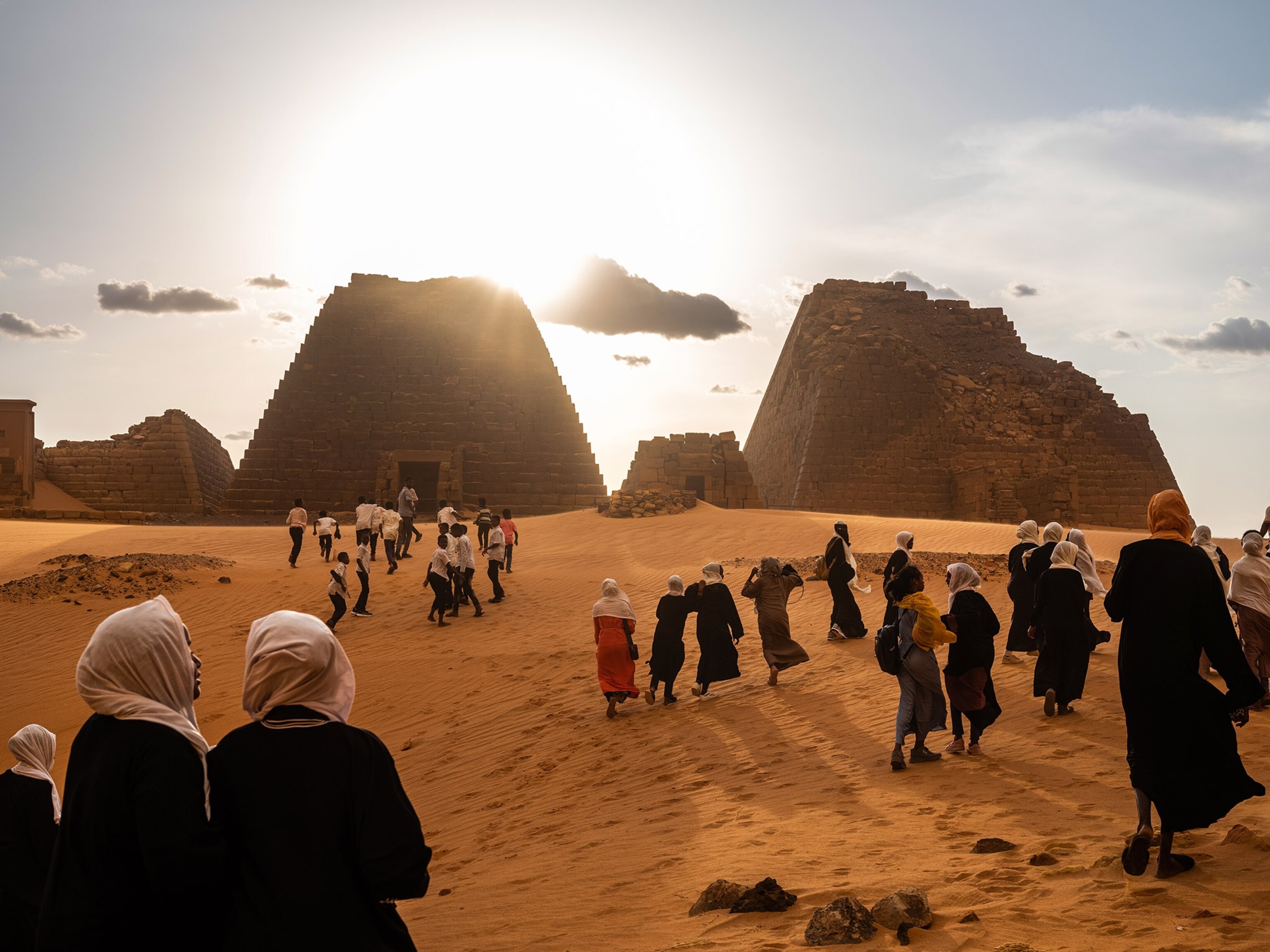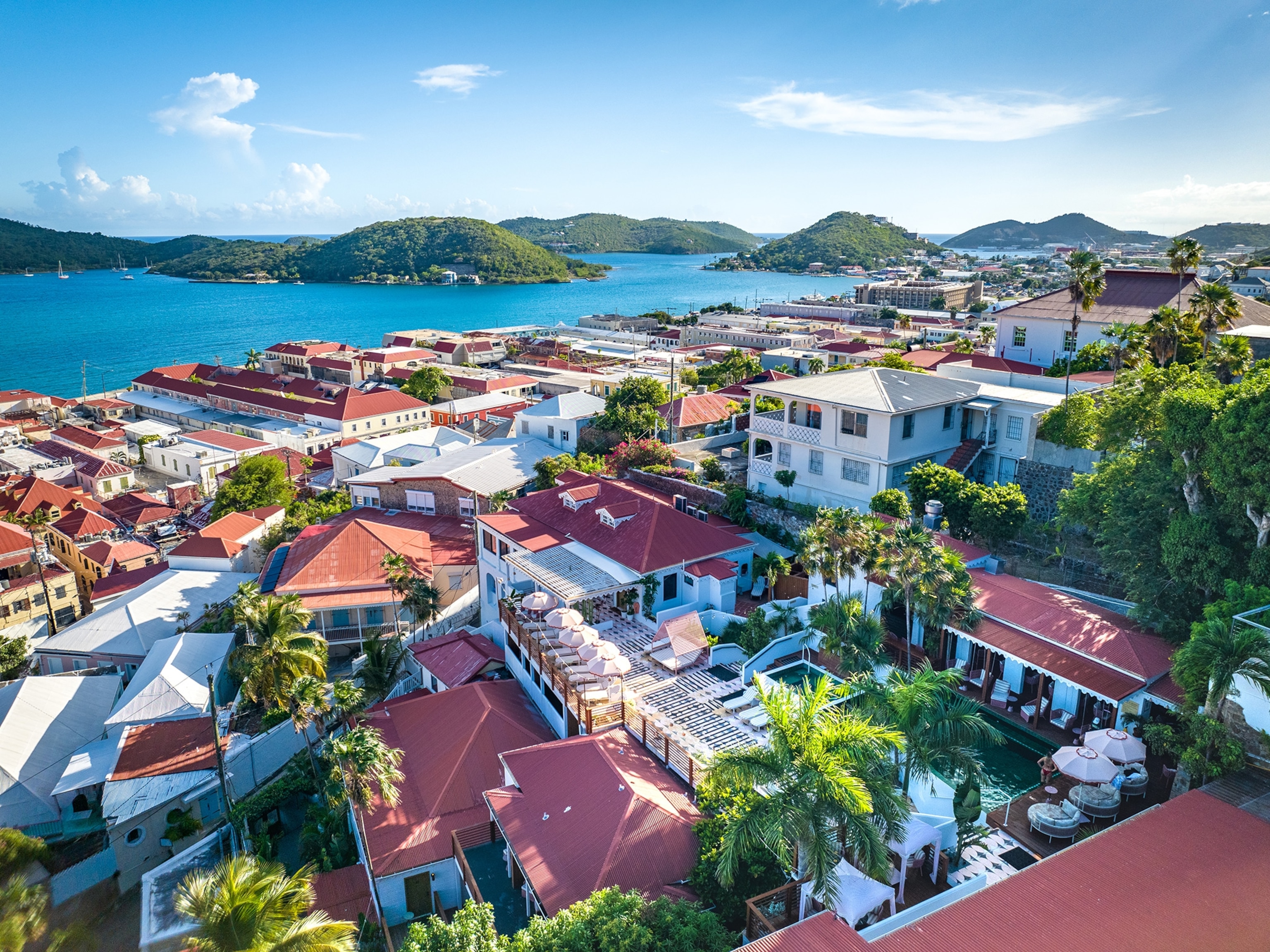
These mighty pyramids were built by one of Africa’s earliest civilizations
The mysterious rulers of Nubia, in present-day Sudan, erected hundreds of tombs and temples that rival Cairo’s.
Powered by agriculture, ancient Sudan’s great civilizations thrived and erected mighty temples and tombs honoring their gods, kings, queens, and nobles. Their building boom left behind some 255 pyramids—more than twice the number Egypt constructed next door.
Yet few Western travelers have seen these hulking sandstone relics. That’s because Sudan’s tourism industry has been impeded by two civil wars (1956-1972 and 1983-2005) and the battle for independence that led to the creation of South Sudan in 2011.

Travel to Sudan is still currently not advised due to ongoing civil unrest related to a 2021 coup. However, when tensions ease, Sudan offers a singular chance to camp beside crowd-free ancient pyramids and to learn about the mysterious reign of these little-known pharaohs. A guided road trip along the Nile Valley takes you from the splendid temple at Soleb to the UNESCO-recognized Meroë, with the world’s largest cache of pyramids.
Black Pharaohs and a once great city
Nubia once stretched south from Aswan, Egypt, to modern-day Khartoum, Sudan. It gave rise to one of Africa’s earliest civilizations, the Kingdom of Kush, whose kings—nicknamed the Black Pharaohs—conquered Egypt in 747 B.C. and ruled the vast territory for nearly a century.
This drama played out on the banks of the world’s longest river, the Nile. Flowing south to north from Lake Victoria to the Mediterranean, the legendary waterway was considered the source of life itself because the annual flooding brought fertile soil for farming.
From the capital of Khartoum, it’s a nine-hour drive north to Soleb, Sudan’s best-preserved temple and the southernmost structure built by Amenhotep III, the Egyptian pharaoh who also commissioned the temples at Luxor. It was once guarded by the Prudhoe Lions, a pair of finely carved red granite beasts inscribed by the boy-king Tutankhamun when he visited. They are now displayed at London’s British Museum.


Take a small barge from the village of Wawa to the western bank of the Nile, and you soon see the sandstone columns of Soleb’s main hall. Carved at their bases are images of Assyrians, hands chained behind their backs, whom the Black Pharaohs took as prisoners of war.
(Learn how the Nubian kingdom of Kush exuded power and gold.)
A few miles south of Soleb, set back from the tents where locals serve small glasses of tea beside the Nile, is Kerma. Established around 5,500 years ago, this ancient capital grew up around a huge adobe temple called the Western Defuffa. At its height the city had a population of 10,000; today, its mud brick ruins are inhabited only by nesting swallows. Nearby lies one of the oldest cemeteries in Africa.

Haunting tombs and dazzling murals
Just over an hour’s drive south, and slowly being swallowed by sand, is Old Dongola. Founded with a fortress in A.D. 600, it served as the capital of the medieval Nubian kingdom of Makuria and grew to include palaces, houses, and Christian churches. It was a major stop on the Darb al-Arba’in (Forty Days Road) that thousands of camel caravans followed, transporting ivory and slaves between the Sudanese town of Darfur and Egypt.
Best preserved is the Church of the Old Granite Columns, its pale pillars framing a Throne Hall that was converted into a mosque in 1317 and remained in use until 1969. Now it’s open to visitors, along with an adjacent Islamic graveyard with distinctive 17th-century domed tombs known as qubbas.
From there, the Nile loops eastward and you come to El-Kurru, a cemetery used by the royal family of the Kingdom of Kush. Unlike in Egypt, Nubian burial chambers sit below the pyramids, not inside them.

Adobe tunnels cover the entrances to the chambers, chief among them the tomb of King Tanutamun (who died around 653 B.C.). Uneven shallow steps descend into the darkness until a flashlight click reveals a duo of domed rooms, one leading onto the other. Their white gypsum walls are covered with intricate murals in colors of ocher and yellow.
On the back wall is an arresting scene depicting Tanutamun’s heart being weighed against a feather by Maat, the goddess of truth. Kushites believed this recorded a person’s good and bad deeds and determined if the king’s soul could pass into paradise.

More royal tombs crop up in Nuri, further upstream. Its smaller and steeper 70-plus pyramids are now reduced to 20. The most famous tombs belong to King Taharqa, the Black Pharoah who conquered Egypt, and King Nastasen, which archaeologists have to scuba-dive to reach because of rising ground waters.
(See what it’s like to dive underneath a pyramid.)
Nuri served as the royal necropolis for the adjacent town of Napata, the first capital of the Kingdom of Kush. Both the cemetery and the ruins of the settlement lie across the Nile from Jebel Barkal, a 341-foot-tall sandstone mesa. From its summit, you can see the ruins of Nuri, including rows of cracked pillars and pairs of giant stone rams, their eyes and ears worn away by time.


On the western side of Jebel Barkal is a crumbling stone door frame leading to the Temple of Mut, wife of Amun. Spotlights illuminate its fine wall murals chronicling Taharqa’s coronation in white clay, ocher, and deep blue.
The world’s largest group of pyramids
Finally, the Nile weaves past Meroë (pronounced Mero-way), the Kushite capital until the empire collapsed in A.D. 400 and site of Sudan’s best-preserved pyramids. More than 200 of them spread across the sands. Their granite and sandstone bases are etched with elephant, giraffe, and gazelle designs, proof that this was once fertile grasslands.

“It’s the biggest congregation of pyramids in the world,” reports archaeologist and Meroë site manager, Mahmoud Suliman. “At the time of the 2019 revolution, street signs, advertisements, and paintings all featured their images. It brought people together because the pyramids are so tied to our sense of identity.”
Mentioned in the writings of Herodotus, there’s an air of defiance about these structures that stand firm against the sands trying to swallow them. Indeed, it was an act of resistance that led to their construction in the first place. In the third century B.C., Kushite King Arakamani (Ergamenes) had grown tired of the Meroitic (Meroë-led) kingdom’s power-hungry high priests. So when they sent an order for him to commit suicide, he responded by having them all murdered instead.


The rebellion ushered in a new era of culture: the almighty Egyptian god Amun-Ra was downgraded in favor of the lion god Abedemak, the (still undeciphered) Meroitic script was created, and warrior queens, known as kandakes, ruled the army. Inside the tombs, the carvings of the kings stand taller than the gods. You won’t see that in Egypt. Here, kings controlled everything except death.
It’s a strong message and one that’s inspired a fresh wave of national pride. For just as Ancient Greece informed so much of today’s European culture, so too did Nubia shape Sudan. It is the bedrock that formed the country’s sense of self and identity. Understanding this history suggests a way forward for Sudan.
“These were very popular kings and queens,” says Aya Allam, a Sudanese martial artist based in Khartoum. “They are a reminder that we were once a great nation and could become great once again.”

You May Also Like
Go Further
Animals
- Orangutan seen using plants to heal wound for first timeOrangutan seen using plants to heal wound for first time
- What La Palma's 'lava tubes' tell us about life on other planetsWhat La Palma's 'lava tubes' tell us about life on other planets
- This fungus turns cicadas into zombies who procreate—then dieThis fungus turns cicadas into zombies who procreate—then die
- How can we protect grizzlies from their biggest threat—trains?How can we protect grizzlies from their biggest threat—trains?
- This ‘saber-toothed’ salmon wasn’t quite what we thoughtThis ‘saber-toothed’ salmon wasn’t quite what we thought
- Why this rhino-zebra friendship makes perfect senseWhy this rhino-zebra friendship makes perfect sense
Environment
- What La Palma's 'lava tubes' tell us about life on other planetsWhat La Palma's 'lava tubes' tell us about life on other planets
- How fungi form ‘fairy rings’ and inspire superstitionsHow fungi form ‘fairy rings’ and inspire superstitions
- Your favorite foods may not taste the same in the future. Here's why.Your favorite foods may not taste the same in the future. Here's why.
- Are the Great Lakes the key to solving America’s emissions conundrum?Are the Great Lakes the key to solving America’s emissions conundrum?
- The world’s historic sites face climate change. Can Petra lead the way?The world’s historic sites face climate change. Can Petra lead the way?
History & Culture
- Meet the ruthless king who unified the Kingdom of Hawai'iMeet the ruthless king who unified the Kingdom of Hawai'i
- Hawaii's Lei Day is about so much more than flowersHawaii's Lei Day is about so much more than flowers
- When treasure hunters find artifacts, who gets to keep them?When treasure hunters find artifacts, who gets to keep them?
- Meet the original members of the tortured poets departmentMeet the original members of the tortured poets department
Science
- Why ovaries are so crucial to women’s health and longevityWhy ovaries are so crucial to women’s health and longevity
- Orangutan seen using plants to heal wound for first timeOrangutan seen using plants to heal wound for first time
- Should you be concerned about bird flu in your milk?Should you be concerned about bird flu in your milk?
Travel
- On this Croatian peninsula, traditions are securing locals' futuresOn this Croatian peninsula, traditions are securing locals' futures
- Are Italy's 'problem bears' a danger to travellers?Are Italy's 'problem bears' a danger to travellers?
- How to navigate Nantes’ arts and culture scene
- Paid Content
How to navigate Nantes’ arts and culture scene







